Winter driving can be scary and takes extra awareness and concentration. The safest thing you can do while driving on ice and snow? Slow down and be patient.
Many winter driving accidents are caused by motorists traveling too fast for the weather conditions. Overconfidence in one's abilities and vehicle is a factor in many of the serious and fatal winter accidents, according to IcyRoadSafety.com.
More than 800 people die each year in the U.S. in vehicle crashes caused by snow, sleet and freezing rain, according to a study by University of Georgia researcher Alan Black. The study found that from 1996 to 2011, more than 12,000 people died in the U.S. in vehicle accidents that happened during winter precipitation. The average per year was 817 deaths.
Fatalities were higher than expected in heavy snowfall regions in the West and the areas downwind of lakes Erie and Ontario.
Driving on ice and snow is tricky, but here are 15 tips that should help:
1. Allow plenty of time to arrive at your destination.
Trips can take longer during winter than other times of the year, especially if you encounter snow or icy roads. Don’t rush!
Plan your route and let others know your route and anticipated arrival time.
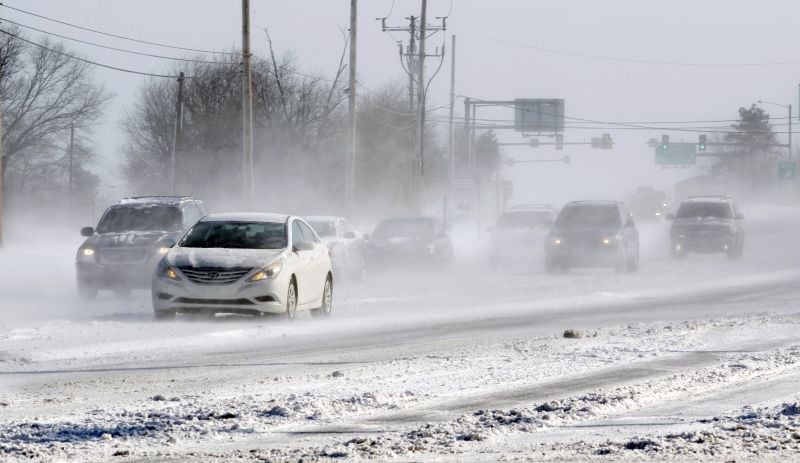
Motorists drive their cars through blowing snow Sunday, Feb. 15, 2015, in Yardley, Pa. (Photo: Mel Evans/AP Photo)
2. Slow down.
Accelerating, stopping and turning all take longer on snow-covered roads. Give yourself time to maneuver by taking it slow. Applying the gas slowly to accelerate is the best method for regaining traction and avoiding skids.
Avoid sudden stops and quick direction changes. And take time to slow down for a stoplight. Coasting through a turn works best in deep snow or on icy roads.
Related: Stay safe when driving this winter
Drive like you’re tiptoeing on ice, because you might be.
If you are driving a 4x4 vehicle, don't get overconfident. Remember that, if you are driving a four-wheel-drive vehicle, the vehicle may help you get going quicker, but it won't help you stop any quicker. Many 4x4 vehicles are heavier than passenger vehicles and actually may take longer to stop.
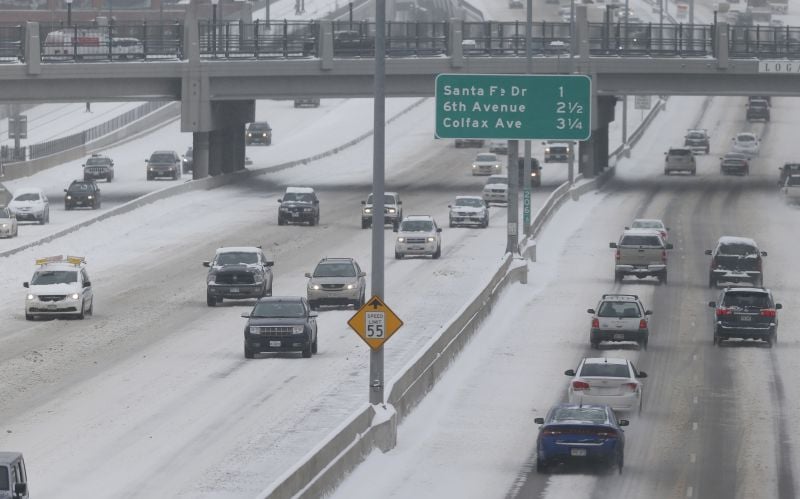
Motorists proceed along the slick roadway of Interstate 25 as high winds drive snow into drifts on Tuesday, Dec. 15, 2015, in Denver. (Photo: David Zalubowski/AP Photo)
3. Leave plenty of distance between your vehicle and the one just ahead of you.
Give yourself at least 10 seconds to come to a complete stop. Cars and motorcycles usually need at least 3 seconds to halt completely even when traveling on dry pavement. This increased margin of safety will provide the longer distance needed if you have to stop.
A good rule of thumb is that you should be around 20 seconds behind the car in front of you if the road is icy. That way, if that car has to stop suddenly — or worse still, crashes into a car in front — you will have time to stop, or take avoiding action.
To check you’re far enough away, watch for the car in front to pass an object — a lamp post, bridge or sign. Then count how many seconds go by before you pass the same object. If it’s under 20 seconds, you should back off and allow more space.
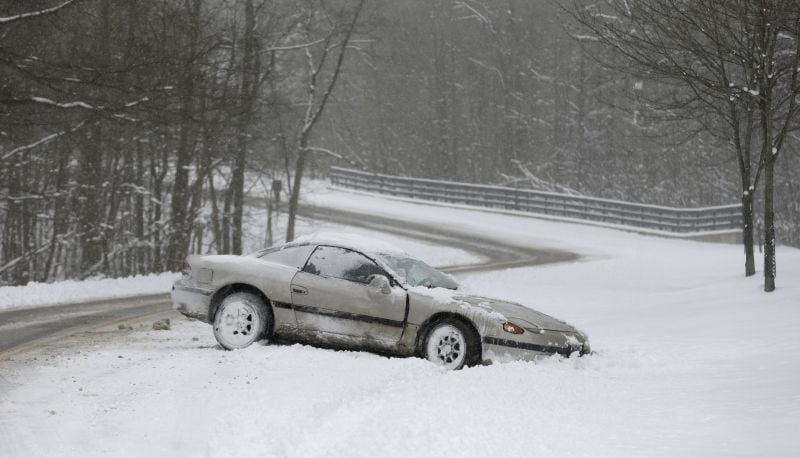
A car rests on the side of the road in the snow Friday, Feb. 1, 2013, in Solon, Ohio. (Photo: Tony Dejak/AP Photo)
4. If you go into a skid, ease your foot off the accelerator.
If you find yourself in a skid, stay calm and ease your foot off the gas while carefully steering in the direction you want the front of your vehicle to go. Hold the steering wheel firmly, but don’t make large turns. Use a light touch to correct the swerve.
Continue to stay off the pedals (gas and brake) until you are able to regain control of your vehicle. Avoid using the brakes, as this will prolong the skid.
If the car starts to spin while you are skidding, steer into the direction of the spin and allow the car to straighten up.
Most modern cars have extremely well-developed stability-control systems, and if you turn the wheel slowly towards the slide and avoid stepping on the brake too hard, those systems will do a good job of straightening you out.
Rear-wheel skids
If the rear wheels lose traction, use these steps to regain control:
- Continue to look at your path of travel down the road.
- Steer in the direction you want the front of the vehicle to go.
- Avoid slamming on the brakes. Although hitting the brakes is a typical response, slamming the brake will only furher upset the vehicle's blance and make it harder to regain control.
- When the rear wheels stop skidding, continue to steer to avoid a re-wheel skid in the opposite direction.
Front-wheel skids
Front-wheel skids are caused by hard braking or acceleration if your vehicle has front-wheel drive. When the front wheels lose traction, you'll not be able to steer the vehicle.
Compared to rear-wheel skids, front-wheel skids are easier to correct and less hazardous because there is no risk of the vehicle skidding in the opposite direction. Regardless of whether the vehicle has front-, rear- or four-wheel drive, the best way to regain control of the front wheels skid is:
- Continue to look where you want to go.
- Steer in the direction you want the front of the vehicle to go.
- Avoid slamming on the brakes. Although hitting the brakes is a typical response, slamming the brakes will only further upset the vehicle's balance and make it harder to regain control.
- Wait for the front wheels to grip the road again. As soon as traction returns, the vehicle will start to steer again.
- When the front wheels have regained their grip, steer the wheels gently in the desired direction of travel.
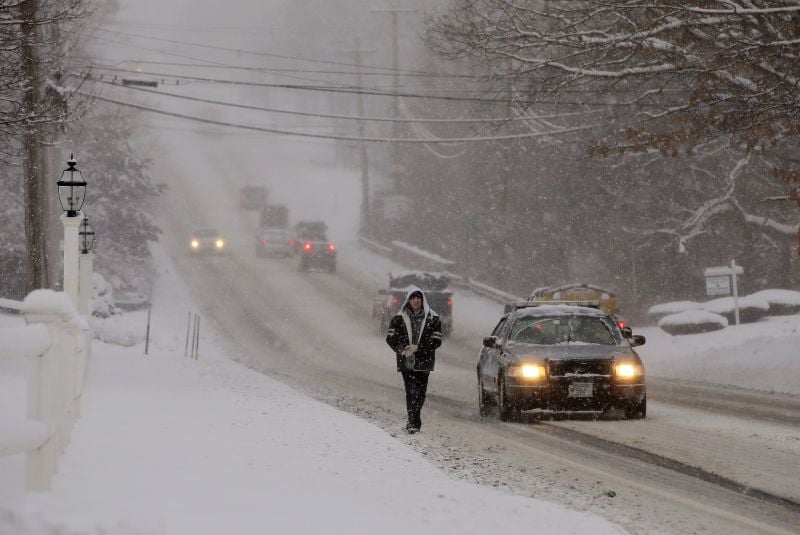
Traffic is sparse and the sidewalks impassable as a heavy snow falls in Pembroke, Mass., Wednesday morning, Feb. 5, 2014. (Photo: Stephan Savoia/AP Photo)
5. Don't power up hills.
Applying extra gas on snow-covered roads just starts your wheels spinning. Try to get a little momentum going before you reach the hill and let that inertia carry you to the top. As you reach the crest of the hill, reduce your speed and proceed down hill as slowly as possible.
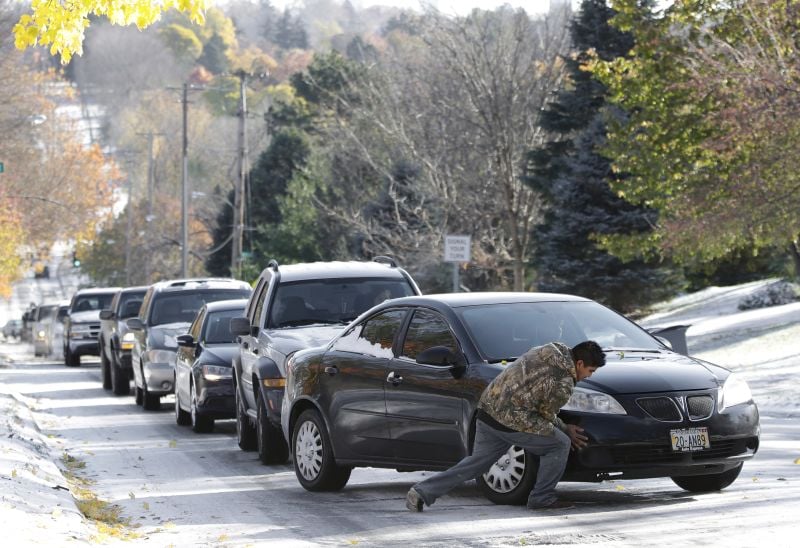
A good samaritan helps push a car stuck on an icy road in Omaha, Neb., Tuesday, Nov. 11, 2014. (Photo: Nati Harnik/AP Photo)
6. Don’t stop going up a hill.
Get some momentum going on a flat roadway before you take on the hill. It can be a challenge to get moving up a hill on an icy road.
Easing off the gas will rob you of the momentum you need to counteract gravity as it tries to pull your car down the hill. Conversely, giving the car too much gas could leave your wheels spinning and you sliding backward.
By avoiding paths taken by other vehicles, you might have a chance at having better traction.
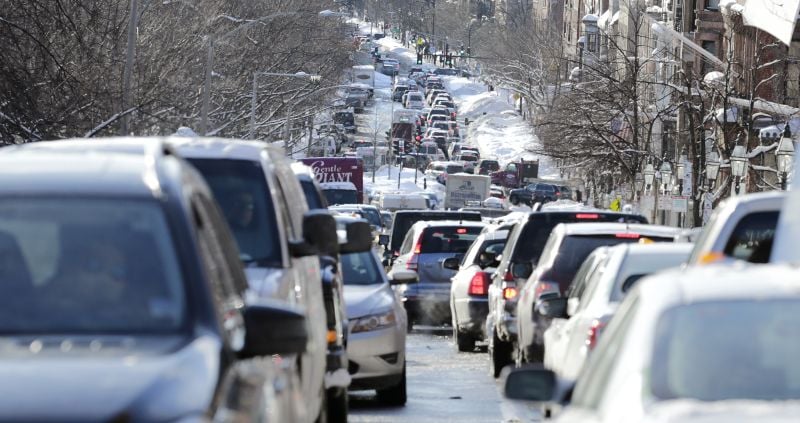
Cars are gridlocked on Beacon Street in Boston, Tuesday, Feb. 3, 2015. The Boston area received about 40 inches of snow, causing significant traffic on the roads narrowed because of snow banks. (Photo: Charles Krupa/AP Photo)
7. Keep your gas tank at least half full.
Keep your gas tank close to full, even with a hybrid-electric vehicle. If you get stuck in a traffic jam or in snow, you might need more fuel than you anticipated to get home or to keep warm. A fuller gas tank also averts the potential freezing of your car's fuel line.
More gas also means more weight, which can provide better traction.
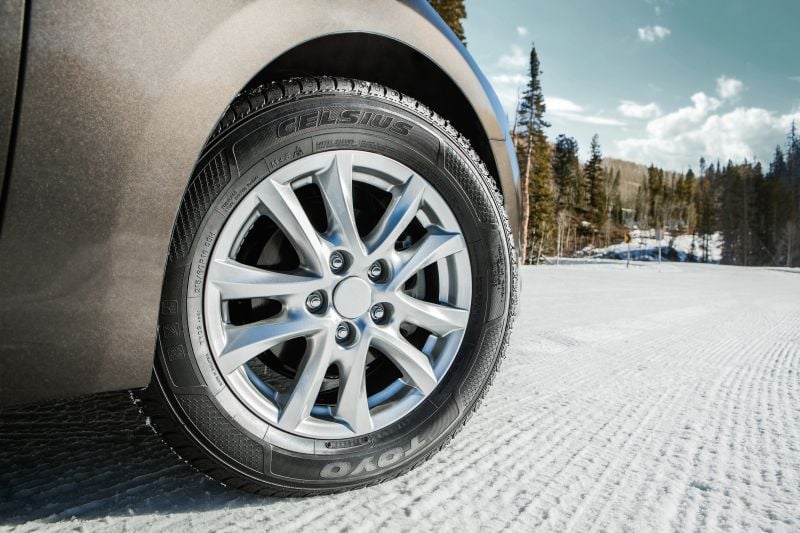
Good tires are key to driving in snow. (Photo: Toyo Tire via PRNewsFoto)
8. Check your tires.
Keep your tires properly inflated and remember that for winter weather driving, a general rule is the more tread depth, the better.
A good snow tire helps you in two ways. Its deeper tread is designed to cut through snow and reach the pavement. More importantly, the rubber that makes up that tread is chemically formulated, and softer, to better grab the asphalt in cold weather.
If you drive more on icy road than snowy roads, studded tires may be the right choice for you.
Tire pressure decreases by about one pound per square inch for every 10-degree drop in outside air temperature, so it's vital that you check the air pressure regularly in winter weather.
Drivers should follow the guidelines found in the vehicle owner’s manual or tire placard (or sticker) attached to the vehicle door edge to determine the correct air pressure for their vehicle's tires. A common myth is that the tire pressure listed on the sidewall is the optimal pressure, while in reality it is the maximum pressure.
Don’t forget to check your spare tire. If you need to use your spare tire, you don’t want to find out that it is flat.
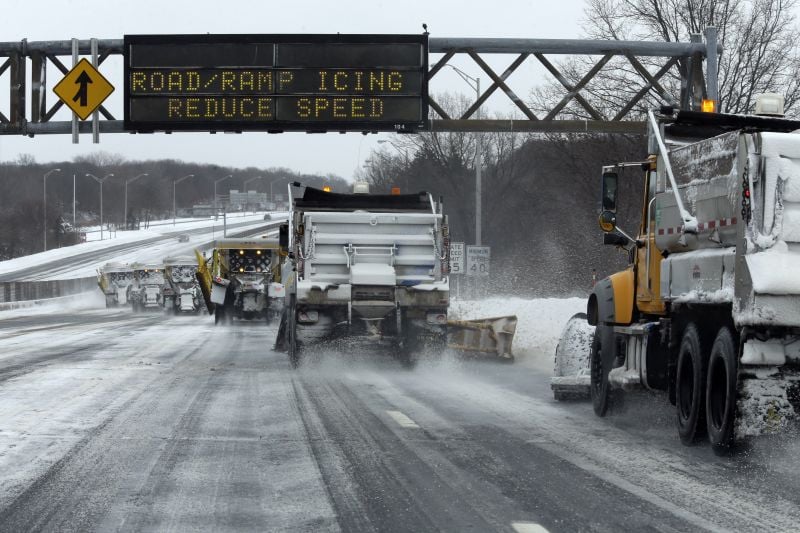
Snow plows clear the Long Island Expressway, Tuesday, Jan. 27, 2015 in Central Islip, N.Y. A storm packing blizzard conditions spun up the East Coast, pounding coastal eastern Long Island into Maine with high winds and heavy snow. (Photo: Mary Altaffer/AP Photo)
9. Don't crowd a snow plow or travel beside it.
When you are driving behind a snow plow, don’t follow or stop too closely. A snow plow operator’s field-of-vision is limited; if you can't see the mirrors, the driver can't see you. Also, materials used to de-ice the road could hit your vehicle.
Snow plows can throw up a cloud of snow that can reduce your visibility to zero in less time than you can react. Never drive into a snow cloud — it can conceal vehicles or hazards.
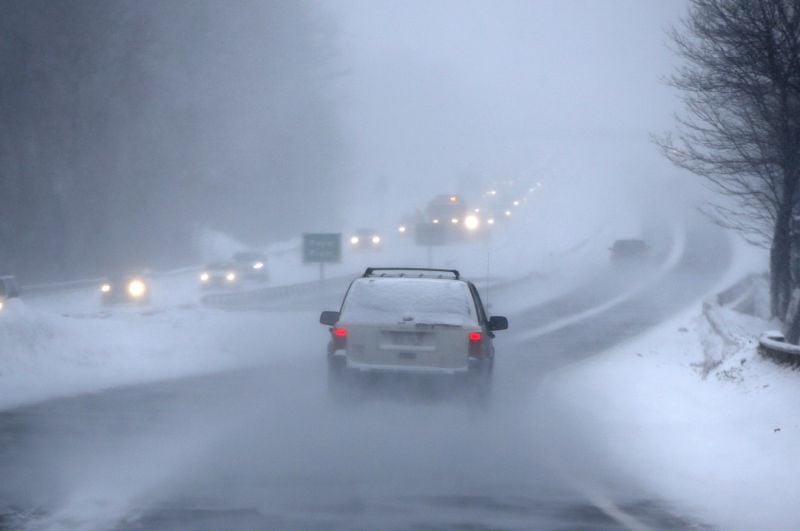
Drivers on I-295 contend with near-whiteout conditions while driving in a snow storm Monday, Feb. 2, 2015, in Yarmouth, Maine. (Photo:Robert F. Bukaty/AP Photo)
10. Don't use your cruise control while driving on ice or snow.
Even roads that appear clear can have sudden slippery spots and the slightest touch of your brakes to deactivate the cruise control can cause you to lose control of your vehicle.
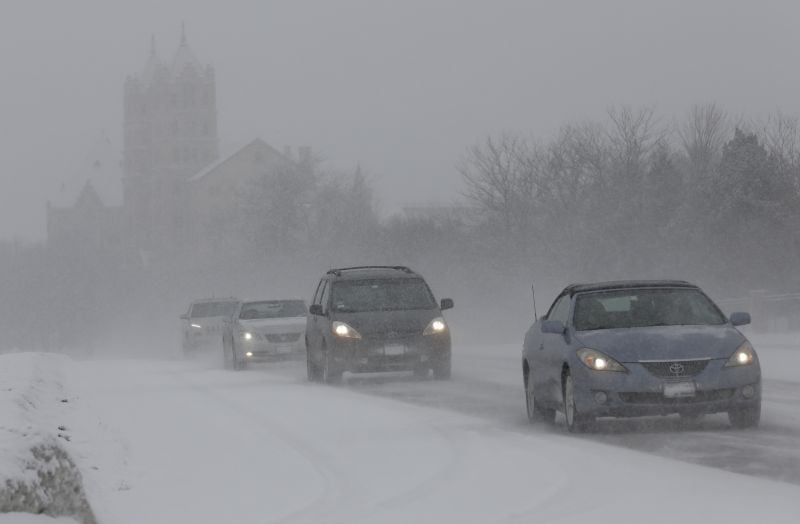
Traffic slowly moves down Waukegan Road on Sunday, Feb. 15, 2015, in Northbrook, Ill. Lake-effect snow caused slippery conditions on some area roadways close to Lake Michigan, leading to multiple accidents. (Photo: Nam Y. Huh/AP Photo)
11. Turn on your headlights.
Even during the day, snow or overcast conditions can make it difficult to see the road and other vehicles.
 Good samaritans try to push a car stuck in the snow in Trenton, N.J. After pummeling wide swaths of the Southeast, a winter storm dumped more than a foot of snow in parts of the Mid-Atlantic region as it marched Northeast and threatened more power outages, traffic headaches and widespread closures for millions of residents. (Photo: Mel Evans/AP Photo)
Good samaritans try to push a car stuck in the snow in Trenton, N.J. After pummeling wide swaths of the Southeast, a winter storm dumped more than a foot of snow in parts of the Mid-Atlantic region as it marched Northeast and threatened more power outages, traffic headaches and widespread closures for millions of residents. (Photo: Mel Evans/AP Photo)
12. Avoid spinning the tires if you become stuck in the snow or on an icy patch.
First, disengage the car’s traction control system (there’s usually a button for this on the dashboard somewhere), which actually tends to work against your efforts when there’s zero traction.
Spinning the tires will get you into a deeper rut. Instead, gradually rock the vehicle back and forth to get it unstuck. Engage the lowest gear (second gear if it’s a manual transmission) and slowly creep ahead as far as possible — perhaps only an inch or two at a time — then engage the brakes, put the car into reverse and repeat the process back and forth several times to gradually get unstuck.
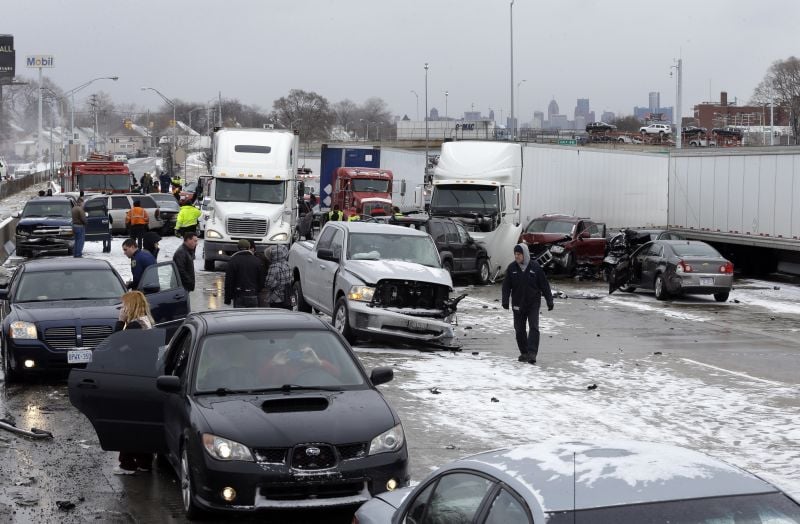
A section of multi-vehicle accident on Interstate 75 is shown in Detroit, Thursday, Jan. 31, 2013. Snow squalls and slippery roads led to a series of accidents that left at least three people dead and 20 injured on a mile-long stretch of southbound I-75. More than two dozen vehicles, including tractor-trailers, were involved in the pileups. (Photo: Paul Sancya/AP Photo)
13. If you can't avoid a collision ...
If after all your efforts you can't avoid hitting something, remember your car offers you more protection in a head-on crash than a side impact, according to DrivnginSnow.net. There's a lot more energy-absorbing metalwork between you and the front bumper, than between you and the outside of the door.
Seatbelts and frontal airbags work much better in a frontal impact, and many cars don't have side-impact airbags.
If you slide sideways into a curb or soft ground, your car may roll over (particularly in a tall 4x4 vehicle), whereas if you hit them forwards, you will probably keep going.
So, travelling sideways is not good — if you are able to turn at the last minute, try to hit things head on.
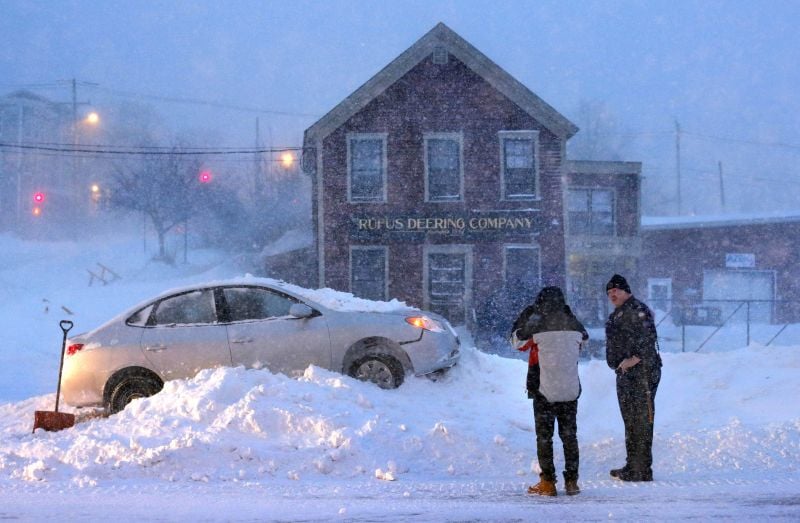
A police officer questions the driver an occupant of a car that ended up on top of a tall snowbank in the middle of Commercial Street during a blizzard, Tuesday, Jan 27, 2015, in Portland, Maine. Although there was no driving ban in Maine, most motorists stayed off the roads. (Photo: Robert F. Bukaty/AP Photo)
14. Drive only if it's absolutely necessary.
If you must drive, travel in the day and don’t travel alone. Stay on main roads and avoid back road shortcuts.
Take heed of warnings not to go out. This leaves the emergency services free to deal with real emergencies instead of rescuing stranded motorists.
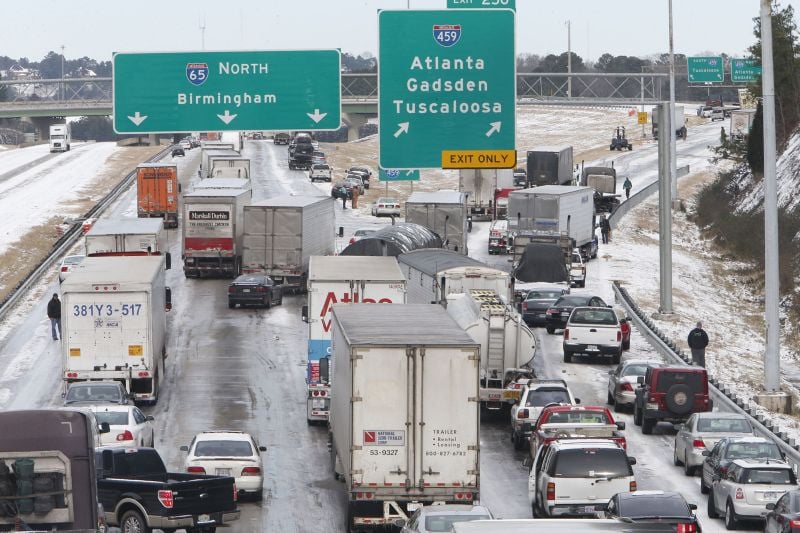
Traffic is at a standstill on Interstate 65 northbound as officials work to clear abandoned vehicles Wednesday, Jan. 29, 2014 in Hoover, Ala. Some commuters pleaded for help via cellphones while still holed up in their cars, while others trudged miles home, abandoning their vehicles outright. (Photo: Hal Yeager/AP Photo)
15. Stay with your car if you're stranded in wintry weather.
Your vehicle provides temporary shelter and makes it easier for rescuers to locate you.
Alert others to your presence by turning on your hazard lights, activating road flares or placing a brightly colored cloth on the vehicle's antenna or door handle. Turn on a flashlight or keep the interior dome light turned on.
To avoid asphyxiation from carbon monoxide poisoning, don’t run your car for long periods of time with the windows up or in an enclosed space. If you must run your vehicle, clear the exhaust pipe of any snow and run it only sporadically — no more than 10 minutes per hour — just long enough to stay warm. Make sure to leave a window slightly open for ventilation.
Don't set out on foot unless you can see a building close by where you know you can take shelter. Be careful — distances are distorted by blowing snow. A building may seem close, but be too far to walk to in deep snow.
Please give us a Like on Facebook!
Want to continue reading?
Become a Free PropertyCasualty360 Digital Reader
Your access to unlimited PropertyCasualty360 content isn’t changing.
Once you are an ALM digital member, you’ll receive:
- Breaking insurance news and analysis, on-site and via our newsletters and custom alerts
- Weekly Insurance Speak podcast featuring exclusive interviews with industry leaders
- Educational webcasts, white papers, and ebooks from industry thought leaders
- Critical converage of the employee benefits and financial advisory markets on our other ALM sites, BenefitsPRO and ThinkAdvisor
Already have an account? Sign In Now
© 2025 ALM Global, LLC, All Rights Reserved. Request academic re-use from www.copyright.com. All other uses, submit a request to [email protected]. For more information visit Asset & Logo Licensing.








